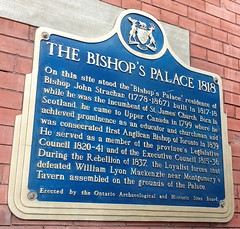

The Rt Rev. John Strachan
(1778-1867)
Bishop, educator, churchman, member of the Executive Council (1815-1836), member of the Legislative Council (1820-1841), and 1st Anglican Bishop of Toronto (from 1839)
Died aged c. 89
Wikidata WikipediaJohn Strachan (/ˈstrɔːn/; 12 April 1778 – 1 November 1867) was a notable figure in Upper Canada and the first Anglican Bishop of Toronto. He is best known as a political bishop who held many government positions and promoted education from common schools to helping to found the University of Toronto. Gauvreau says in the 1820s he was "the most eloquent and powerful Upper Canadian exponent of an anti-republican social order based upon the tory principles of hierarchy and subordination in both church and state". Craig characterizes him as "the Canadian arch tory of his era" for his intense conservatism. Craig argues that Strachan "believed in an ordered society, an established church, the prerogative of the crown, and prescriptive rights; he did not believe that the voice of the people was the voice of God". Strachan built his home in a large yard bound by Simcoe Street, York Street, and Front Street. It was a two-storey building that was the first building in Toronto to use locally manufactured bricks. The gardens and grounds of the property occupied the entire square and became a local Toronto landmark, being given the name "The Bishop's Palace". After Strachan's death, the home was converted into a private hotel called The Palace Boarding House.
DbPedia
Commemorated on 1 plaque
The Bishop's Palace 1818 On this site stood the "Bishop's Palace", residence of Bishop John Strachan (1778-1867), built in 1817-18 while he was the incumbent of St. James' Church. Born in Scotland, he came to Upper Canada in 1799 where he achieved prominence as an educator and churchman and was consecrated first Anglican Bishop of Toronto in 1839. He served as a member of the province's Legislative Council 1820-41 and of the Executive Council 1815-36. During the Rebellion of 1837, the Loyalist forces that defeated William Lyon Mackenzie near Montgomery's Tavern assembled on the grounds of the Palace.
150 Front Street West, Toronto, ON, Canada where they lived
